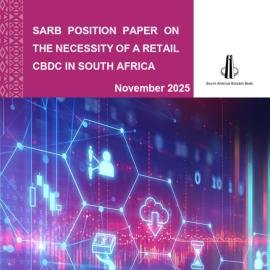The South African Reserve Bank’s (SARB) position paper on a retail central bank digital currency (CBDC) in South Africa has concluded that it there is no compelling immediate need for its implementation.
A retail CBDC is defined as a purely digital banknote, denominated in the national unit of account, which could be used by individuals to pay businesses, shops or each other (a retail CBDC), or between financial institutions to settle trades in financial markets (a wholesale CBDC).
At its core then, retail CBDC aims to mirror traditional currency, but in digital form.
“The SARB’s research and experimentation found that a retail CBDC is technically feasible and could be implemented in a way that aligns with regulatory and policy objectives.
“However, the analysis does not reveal a strong immediate need for such an instrument. Instead, the SARB concluded that ongoing initiatives such as the Payment Ecosystem Modernisation Programme and expanding non-bank participation in the national payment system should remain the priority in the short-to-medium-term,” the Reserve Bank said.
The SARB position paper on the necessity of a retail CBDC in South Africa and background note was published on the bank’s website on Thursday.
The study focused on the potential role of a retail CBDC as a digital complement to cash, particularly in the context of South Africa’s evolving payment landscape and persistent financial inclusion challenge.
The SARB noted that in the longer term there may be a need for a retail CBDC to safeguard public access to central bank money − a public good that remains essential in a digital economy; and unlock opportunities to complement and enhance the existing payments landscape while supporting broader financial innovation in South Africa.
While the SARB does not currently advocate for the implementation of a retail CBDC, it will continue to monitor developments and will remain prepared to act should the need arise.
“As the SARB continues its CBDC journey, the next phase will pivot toward further exploration of wholesale CBDC. This strategic shift reflects the growing global momentum around wholesale applications and their potential to enhance financial market innovation, cross-border payment efficiency and systemic resilience. The SARB will outline its plans for this next phase in due course.”
Central bank money plays a crucial role in the financial system for two primary reasons: it represents the highest quality of money, reducing risk and enhancing payment system efficiency and its accessibility through convertibility with commercial bank money fosters trade efficiency and mitigates financial instability in a dual money system.
Growth and cash
“From the research and analysis conducted as part of this study, there is evidence of significant growth in the adoption and use of digital payments in South Africa.
“This has been driven by innovative solutions introduced by commercial banks, fintechs and the efforts of the SARB and other public sector agencies and partners,” it said.
These are anticipated to continue having a positive impact on financial inclusion, and it is expected that a growing number of South Africans will adopt and use digital payments on a regular basis.
“Notwithstanding the progress made, evidence also shows that physical cash continues to play a significant role in South Africa, particularly for certain segments of the population. This prevailing cash reliance is due to barriers such as infrastructure availability, costs of digital payments and network and power issues.
Balancing act
“More importantly, the continued ability to redeem private money into safe and liquid public money (i.e. banknotes and coin) provides a safety net in times of economic stress and maintains confidence in the financial system. Further, balancing access to both central bank and commercial bank money is essential for maximising trade efficiency,” SARB said.
This balance requires careful consideration of the unique benefits each type of money provides.
“In the SARB’s view, continued commitment and resources should be dedicated to realising the opportunities of existing payment modernisation initiatives, such as expanding the PayShap value proposition, enabling interoperability of different stores of value, allowing non-banks to issue electronic money and participating directly in the NPS [national payment system], QR code standardisation, introducing an open banking/open finance framework, among others,” the bank said.
SARB emphasised that the conclusion of the study should not be interpreted as a view that South Africa should not implement a retail CBDC in future.
The study can be accessed on: https://www.resbank.co.za/en/home/publications/publication-detail-pages/Fintech/sarb-position-paper-on-the-necessity-of-a-retail-cbdc-in-south-africa
–SAnews.gov.za

